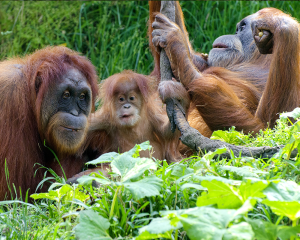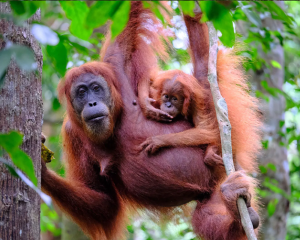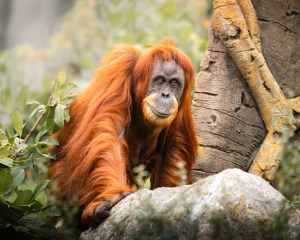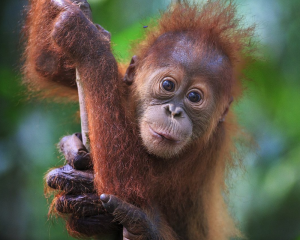
The Sumatran orangutan (Pongo abelii) is a critically endangered species of great ape found only on the island of Sumatra in Indonesia. It is one of three species of orangutans, the others being the Bornean orangutan (Pongo pygmaeus) and the Tapanuli orangutan (Pongo tapanuliensis). Here are some detailed characteristics and information about the Sumatran orangutan:

Physical Characteristics
Size: Sumatran orangutans are the smallest of the three orangutan species. Males typically weigh between 50 to 90 kilograms (110 to 200 pounds) and stand about 1.4 to 1.8 meters (4.6 to 5.9 feet) tall. Females are smaller, weighing around 30 to 50 kilograms (66 to 110 pounds) and standing about 1.2 to 1.4 meters (3.9 to 4.6 feet) tall.
Appearance: They have a distinctive shaggy, reddish-orange coat that is longer and paler compared to the Bornean orangutan. Sumatran orangutans have long, strong arms that can stretch up to 2 meters (6.5 feet) across, well-adapted for their arboreal lifestyle.
Facial Features: Adult males develop large cheek pads, known as flanges, which are less pronounced than those of the Bornean orangutan. They also have a throat sac, which they use to make loud vocalizations called “long calls” to attract females and establish territory.

Behavior
Habitat: Sumatran orangutans are primarily found in the lowland and montane rainforests of northern Sumatra, particularly in the Leuser Ecosystem, which includes the Gunung Leuser National Park. These forests are characterized by a dense canopy and a rich diversity of plant species, providing a crucial habitat for the orangutans.
Diet: Sumatran orangutans are primarily frugivorous, with fruit making up about 60% of their diet. They also eat leaves, bark, insects, and occasionally small vertebrates. They play a vital role in seed dispersal, contributing to the health of the forest ecosystem.
Social Structure: Orangutans are generally solitary, especially males. Females are more social, often accompanied by their offspring. Adult males are typically solitary and highly territorial. Mothers and their dependent young form the strongest social bonds, and a female will typically give birth once every 7 to 9 years, one of the longest birth intervals of any mammal. This slow reproductive rate is a significant factor in their vulnerability to extinction.

Conservation Status
Population: The Sumatran orangutan is critically endangered, with an estimated population of fewer than 14,000 individuals remaining in the wild. This population is fragmented across a few isolated areas in northern Sumatra.
Threats: The main threats to Sumatran orangutans include habitat loss due to illegal logging, palm oil plantations, mining, and infrastructure development. Deforestation and habitat fragmentation make it difficult for orangutans to find food and mates, and also expose them to human-wildlife conflict. Poaching and the illegal pet trade also pose significant threats, although less than habitat destruction.
Conservation Efforts: Conservation efforts for the Sumatran orangutan focus on habitat protection, anti-poaching measures, and public awareness campaigns. National parks and protected areas like the Leuser Ecosystem play a crucial role in safeguarding the remaining populations. Conservation organizations also work to rehabilitate and release orangutans that have been rescued from captivity or conflict situations back into the wild.

Importance
Sumatran orangutans are a keystone species, meaning their presence is crucial for maintaining the structure of their ecosystem. As frugivores, they play a significant role in seed dispersal, which helps maintain the diversity of the forest. Protecting Sumatran orangutans also means protecting a wide range of other species that share their habitat, many of which are also endangered. The conservation of Sumatran orangutans is vital not just for the species itself but for the broader efforts to preserve the unique biodiversity of Sumatra’s rainforests.



